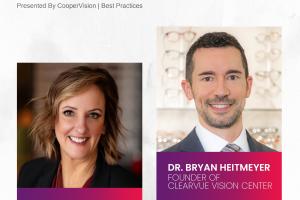
On the surface, eye care practices may seem to patients like they’re all the same. Practitioners take many different approaches to setting themselves apart; for some, it starts with providing a unique patient experience. For 2021 Best Practices Honoree Nicolette Scott, OD, of Broad View Eye Center in Northeast Ohio, that means truly customizing each patient’s visit—based on their personality type.
Learn how Dr. Scott and her staff make this possible, and the benefits to their patients and practice.
Personality Assessments for Your Staff
Understanding various personality types can be beneficial to patient care, but these assessments can also be valuable to the management and development of your staff. Whether you use the DiSC® model, Meyers-Briggs, or others, Dr. Scott suggests that everyone in the office complete some type of personality assessment.
“It’s important for your staff to understand their own personality, and those with whom they work and cater to,” she says.
While Broad View Eye Center doesn’t use the DiSC® analysis during the hiring process, they do have each new employee complete an assessment, as it is helpful in identifying the roles for which they are best suited and which types of training they’ll need.
Dr. Scott also encourages reassessing staff personalities on a regular basis. “It’s by no means etched in stone. Personalities are fluid and they change over time,” she says. “We’ve been using this model for years, and it’s interesting to see how things change as people learn more about themselves and their traits.”
You have a unique way of customizing patient experiences. Tell us about that.
In our practice, we utilize a personality assessment tool to enable our staff to garner a deeper understanding of themselves and our patients. Specifically, we use the DiSC® model, which identifies four main personality types: dominant, influential, supportive and conscientious. Once we determine which profile best fits a patient, we are able to offer a customized experience for anyone who walks through our doors.
How does it work?
We don’t have patients complete the formal DiSC® assessments, but our staff is trained to identify personality types by a patient’s body language or the way they speak. Then we use the general principles of the DiSC® model to deliver a personalized patient care experience. For example, if a patient arrives in a hurry or is particularly assertive, we take note and work to get them in and out—not to rush them, but so they know we’re respectful of their time. For patients who exhibit signs of the “conscientious” type, we make sure to provide them deeper explanations of their prescription. Other patients might talk a lot about themselves and share personal stories, so our staff knows to slow down with them to engage a bit more; this personality tends to appreciate the extra attention. The model provides us a guide for knowing how to best go the extra mile to address each patient’s specific needs.
What have you and your staff learned from the DiSC® model?
We understand now that you may say or do something a certain way to two people and each of them may perceive it completely differently. The DiSC® model has given us perspective by helping us to be more self-aware of our communication and behaviors and how others may interpret them.
What are the benefits of this approach to patient care?
The most significant benefit is in how valued our patients feel. We’re constantly receiving positive reviews and comments about how every person in our office treats patients with the utmost kindness and respect. I think that’s a testament to what the DiSC® training has accomplished.
To learn more about CooperVision’s Best Practices, its prestigious honorees, and the ways they are working to advance the profession, visit eyecarebestpractices.com.








